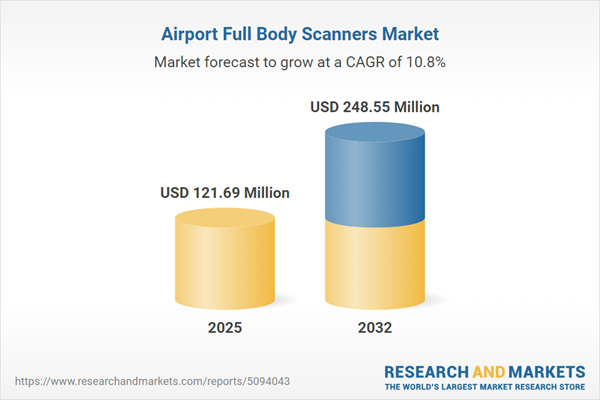Speak directly to the analyst to clarify any post sales queries you may have.
Airport full body scanners are redefining aviation security, offering senior decision-makers solutions that support compliance, risk mitigation, and improved passenger experience. As airports navigate operational complexity, these advanced scanners ensure readiness for shifting regulatory and security challenges.
Market Snapshot: Global Airport Full Body Scanners Market
The global airport full body scanners market is advancing rapidly as airports seek to modernize security infrastructure and optimize passenger processing. With a projected compound annual growth rate (CAGR) of 10.77% through 2032, the sector shows strong momentum. Growth is fueled by investments in sophisticated detection technologies and the ongoing evolution of security protocols as airport operators look to balance operational safety with regulatory adaptability. Regulatory updates continue to shape procurement priorities, with management teams focusing on scanner systems that promote both security and efficient passenger flow.
Scope & Segmentation of the Airport Full Body Scanners Market
A precise understanding of airport full body scanners market segmentation allows leaders to align technology decisions with core security and operational objectives. Each segment shapes investment focus and implementation across airports with diverse needs:
- Technology Type: Backscatter imaging delivers detailed risk-based screening to identify hidden threats, while millimeter wave systems provide flexible, privacy-oriented scanning adaptable to varied terminal environments.
- Deployment Mode: Fixed scanners establish security stability at primary checkpoints; portable units offer critical flexibility during events, facility renovations, or periods of high traveler volume.
- Threat Detection Mode: Automated screening technologies enable efficient processing of travelers, while manual options are used for scenarios requiring in-depth assessment or heightened scrutiny.
- Distribution Channel: Direct original equipment manufacturer (OEM) partnerships enable rapid technology deployment and integrated maintenance; aftermarket channels facilitate upgrades and system life extension.
- Regions: The Americas, Europe, Middle East & Africa, and Asia-Pacific exhibit distinct modernization priorities and regulatory frameworks, directly impacting scanner deployment approaches in each area.
- Sub-Regions: Country-level factors such as regulatory enforcement and passenger travel volumes in markets including the United States, United Kingdom, Germany, France, Canada, Brazil, China, India, Japan, and Australia drive localized adoption and compliance adaptation.
- Key Companies: Providers like OSI Systems, Smiths Detection Limited, Leidos Holdings, Nuctech Company Limited, Thales S.A., L3Harris Technologies, Astrophysics, Inc., and Securaplane Technologies, Inc. offer a variety of platforms to address operational and regional requirements.
Key Takeaways for Senior Decision-Makers
- Align scanner selection with current privacy standards and anticipate regulatory shifts to ensure ongoing compliance and future upgrade capability.
- Utilize millimeter wave technology when facilities require versatile and discreet screening solutions that support flexible terminal layouts and traveler privacy expectations.
- Integrate portable scanner units to safeguard security operations during times of infrastructure updates, high-volume travel periods, or special events, maintaining minimal disruption.
- Pair automated detection processes for efficient throughput with manual screening methods in situations that demand additional scrutiny for improved threat evaluation.
- Develop sustained relationships with OEMs for continued system advancements, complemented by aftermarket services for ongoing maintenance and timely technology enhancements.
Tariff Impact on Airport Full Body Scanners Supply Chains
Global tariff fluctuations are influencing how airport full body scanners are produced and distributed. Manufacturers are addressing these challenges by diversifying supply chain operations and adopting modular product designs. This enables procurement and logistics teams to uphold quality standards, streamline implementations, and adjust to regulatory or market disruptions. Modularity provides adaptable upgrade paths to maintain regulatory alignment and meet evolving security needs efficiently.
Methodology & Data Sources
Findings in this airport full body scanners market research are drawn from executive interviews with stakeholders in airport security, extensive industry surveys, real-time supply chain analysis, and in-depth regulatory review. These methods deliver actionable market intelligence for decision-makers managing procurement and evaluation of scanning solutions.
Why This Report Matters for Airport Security Leaders
- Delivers strategic guidance for aligning investments with international and regional security regulations and emerging policy requirements.
- Offers structural insights into new detection technologies, compliance expectations, and procurement practices to support effective project implementation and lifecycle oversight.
- Supports proactive management of operational risk, performance, and policy adherence within complex airport security environments.
Conclusion
Integrating airport full body scanners enables aviation leaders to meet increasing security expectations and maintain seamless passenger movement. Their adoption fosters resilience, compliance, and reliable operational standards across dynamic travel environments.
Additional Product Information:
- Purchase of this report includes 1 year online access with quarterly updates.
- This report can be updated on request. Please contact our Customer Experience team using the Ask a Question widget on our website.
Table of Contents
3. Executive Summary
4. Market Overview
7. Cumulative Impact of Artificial Intelligence 2025
Companies Mentioned
The companies profiled in this Airport Full Body Scanners market report include:- OSI Systems, Inc.
- Smiths Detection Limited
- Leidos Holdings, Inc.
- Nuctech Company Limited
- Thales S.A.
- L3Harris Technologies, Inc.
- Astrophysics, Inc.
- Securaplane Technologies, Inc.
Table Information
| Report Attribute | Details |
|---|---|
| No. of Pages | 190 |
| Published | October 2025 |
| Forecast Period | 2025 - 2032 |
| Estimated Market Value ( USD | $ 121.69 Million |
| Forecasted Market Value ( USD | $ 248.55 Million |
| Compound Annual Growth Rate | 10.7% |
| Regions Covered | Global |
| No. of Companies Mentioned | 9 |









